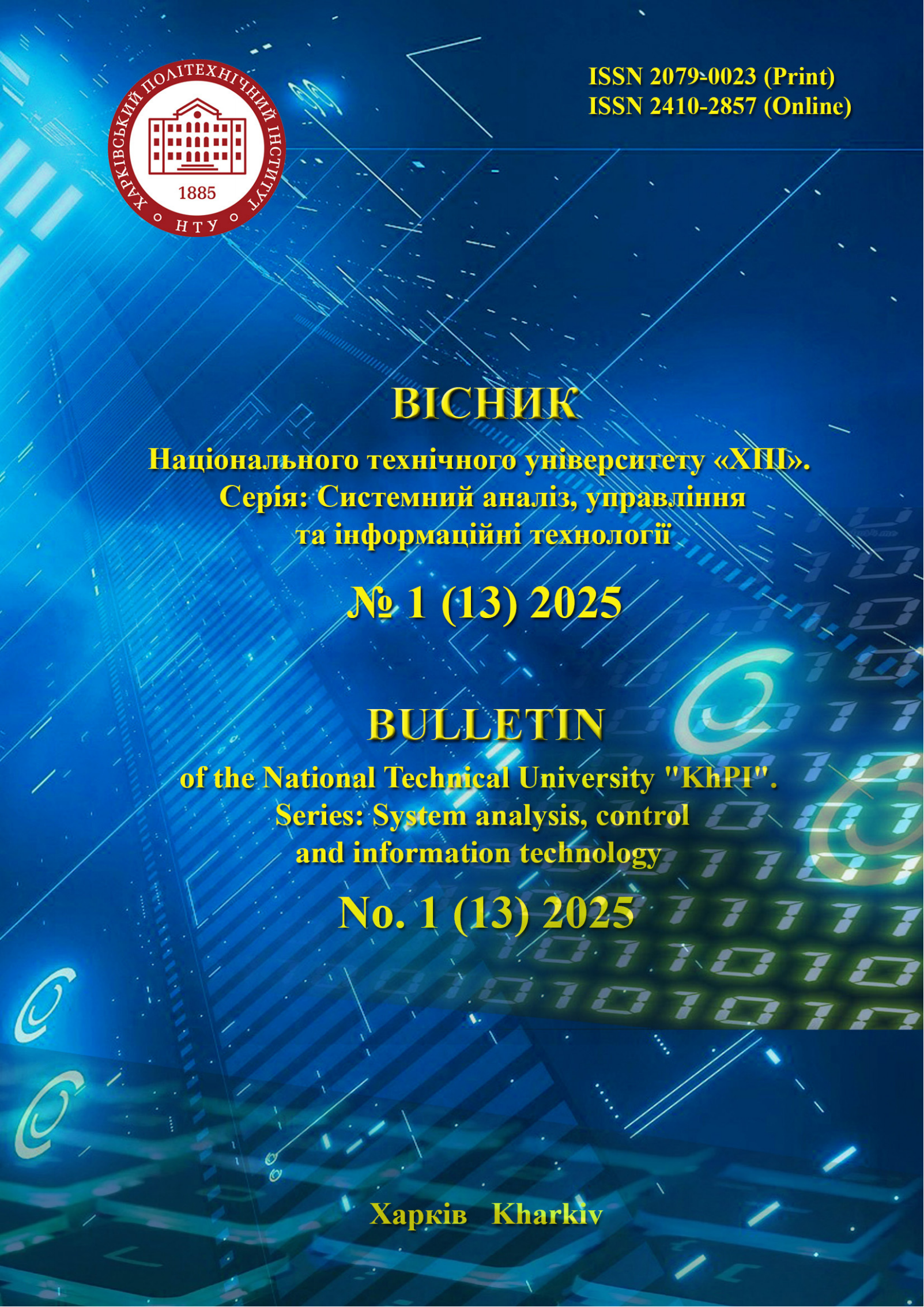DEVELOPMENT OF AN EDUCATIONAL CHATBOT WITH A CONTEXTUAL INTENT SYSTEM ON THE DIALOGFLOW PLATFORM
DOI:
https://doi.org/10.20998/2079-0023.2025.01.03Keywords:
chatbot development, Dialogflow, higher education, student services, prototyping model, intent system, fallback logic, natural language understanding, educational automation, Telegram integrationAbstract
In the context of digital transformation in higher education, the development of intelligent agents capable of maintaining continuous and effective interaction with students is becoming increasingly relevant. This article presents a complete life cycle of the creation of the contextual chatbot “Pytayko z PIITU” for the Department of Software Engineering and Intelligent Control Technologies of NTU “KhPI”. The chatbot is designed to provide quick and intuitive access to information about academic procedures, communication channels, scholarships, documents, and other common questions related to students' interaction with the department and its website. The system was developed using the Dialogflow platform with Telegram integration and Google Cloud Functions as the fulfillment handler. The core of the system is a structured multi-level intent architecture, where each intent group corresponds to a thematic category such as admissions, documents, or course schedules. This allows the bot to maintain conversation context, ensure precise routing of requests, and reduce ambiguity in user interaction. The prototyping model was selected as the life cycle methodology due to the need for active user feedback and iterative improvement. Based on the analysis of the departmental website and survey data from students, an intent system was created that organizes user queries by categories, each with its own fallback intent and context-based clarification mechanisms. Special attention was paid to the dynamic distribution of queries using webhook logic and centralized reusable intent blocks. The article presents the development algorithm, intent architecture, testing process, and analysis of interaction history. The testing phase included multiple validation cycles, real-time sessions via Telegram, and the assessment of fallback effectiveness. The final implementation achieved a high accuracy rate (~91%) and low error percentage (~3%), demonstrating the feasibility of using Dialogflow for educational automation scenarios. The chatbot architecture supports future scalability and provides 24/7 support for student inquiries without additional administrative workload.
References
Bygstad B., Øvrelid E., Ludvigsen S., Dæhlen M. From dual digitalization to digital learning space: Exploring the digital transformation of higher education. Computers & Education. 2022. vol. 182, art. 104463. URL: https://www.sciencedirect.com/science/article/pii/S0360131522000343 (access date: 07.05.2025).
Díaz-García V., Montero-Navarro A., Rodríguez-Sánchez J.-L., Gallego-Losada R. Digitalization and digital transformation in higher education: A bibliometric analysis. Frontiers in Psychology. 2022, vol, 13. art. 1081595. DOI: doi.org/10.3389/fpsyg.2022.1081595.
Rosak-Szyrocka J. The Era of Digitalization in Education: Where do Universities 4.0 Go? Management Systems in Production Engineering. 2024, vol. 32, issue 1, pp. 54–66. DOI: 10.2478/mspe-2024-0006. URL: https://www.researchgate.net/publication/378498067 (access date: 07.05.2025).
George B., Wooden O. Managing the Strategic Transformation of Higher Education through AI. Administrative Sciences. 2023. Vol. 13, no. 9. Art. 196. DOI: doi.org/10.3390/admsci13090196.
Kumar R., Mahmoud M. A. A Review on Chatbot Design and Implementation Techniques. International Journal of Engineering and Technology. 2020. Vol. 7, issue 2. P. 2791–2796. URL: https://www.researchgate.net/publication/340793645 (access date: 07.05.2025).
Barus S. P., Surijati E. Chatbot with Dialogflow for FAQ Services in Matana University Library. International Journal of Informatics and Computation (IJICOM). 2021, vol. 3, no. 2, pp. 68–78. DOI: 10.35842/ijicom.v3i2.75.
Nsaif W. S., Salih H. M., Saleh H. H., Al-Nuaimi B. T. Chatbot Development: Framework, Platform, and Assessment Metrics. The Eurasia Proceedings of Science, Technology, Engineering & Mathematics (EPSTEM). 2024, vol. 27, pp. 50–62.
Dagkoulis I., Moussiades L. A. Comparative Evaluation of Chatbot Development Platforms. 26th Pan-Hellenic Conference on Informatics (PCI 2022). ACM, 2022, pp. 322–328. DOI: doi.org/10.1145/3575879.3576012.
Shevelev, V., & Kopp, A. (2024). Algorithm for comprehensibility evaluation of business process models using natural language processing. Automation of Technological and Business Processes. No.15(4), pp.76–83. DOI: doi.org/10.15673/atbp.v15i4.2721.
Dialogflow ES documentation. URL: https://cloud.google.com/dialogflow/es/docs (access date: 07.05.2025).
Introduction to Rasa Open Source & Rasa Pro. URL: https://legacy-docs-oss.rasa.com/docs/rasa/ (access date: 07.05.2025).
Bocklisch, T., Faulkner, J., Pawlowski, N., & Nichol, A. Rasa: Open source language understanding and dialogue management. arXiv preprint. arXiv:1712.05181. 2017.
Microsoft. My bots. URL: https://dev.botframework.com/ (access date: 07.05.2025).
Amazon Lex – AI Chat Builder. URL: https://aws.amazon.com/lex/ (access date: 07.05.2025).
AI Website Chatbot Comparison – 23 chatbots. URL: https://www.chatlab.com/comparator/chatlab-ibm+watson/?gad_source=1&gad_campaignid=21863828536&gclid=CjwKCAjw_pDBBhBMEiwAmY02NjgZiJypYLZ6o4W76uWSx4mU_aVQRPd2WqoTEE26mpL_4dmO90ek4hoCVv0QAvD_BwE (access date: 07.05.2025).
Burdaev V. About the features of developing intelligent systems for the android platform. Conference proceedings of the VII International Scientific-Practical Conference "Information Technologies in Education, Science and Technology" (ITEST-2024), (Cherkasy, May 23-24, 2024). Cherkasy, ChSTU Publ., 2024, pp. 134–135. https://itest.chdtu.edu.ua/Conference-Proceedings-ITEST-2024_25_06.pdf (access date: 07.05.2025).
Department of Software Engineering and Management Intelligent Technologies. URL: https://web.kpi.kharkov.ua/asu/uk/ (access date: 07.05.2025).
Aminu H., Ogwueleka F. A. Comparative Study of System Development Life Cycle Models. Journal of Emerging Technologies and Innovative Research (JETIR). 2020, vol. 7, issue 8, pp. 200–210. URL: https://www.jetir.org/view?paper=JETIR2008025 (access date: 07.05.2025).
Diansyah A. F., Rahman M. R., Handayani R., Nur Cahyo D. D., Utami E. Comparative Analysis of Software Development Lifecycle Methods in Software Development: A Systematic Literature Review. International Journal of Advances in Data and Information Systems. 2023, vol. 4, no. 2, pp. 97–106. DOI: 10.25008/ijadis.v4i2.1295.
Downloads
Published
How to Cite
Issue
Section
License

This work is licensed under a Creative Commons Attribution 4.0 International License.
Authors who publish with this journal agree to the following terms:
- Authors retain copyright and grant the journal right of first publication with the work simultaneously licensed under a Creative Commons Attribution License that allows others to share the work with an acknowledgement of the work's authorship and initial publication in this journal.
- Authors are able to enter into separate, additional contractual arrangements for the non-exclusive distribution of the journal's published version of the work (e.g., post it to an institutional repository or publish it in a book), with an acknowledgement of its initial publication in this journal.
- Authors are permitted and encouraged to post their work online (e.g., in institutional repositories or on their website) prior to and during the submission process, as it can lead to productive exchanges, as well as earlier and greater citation of published work (See The Effect of Open Access).


